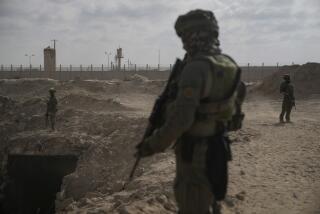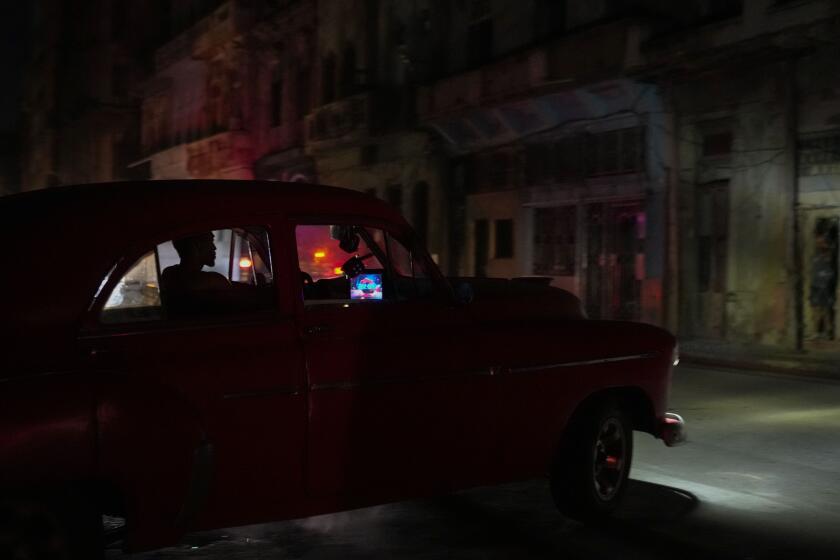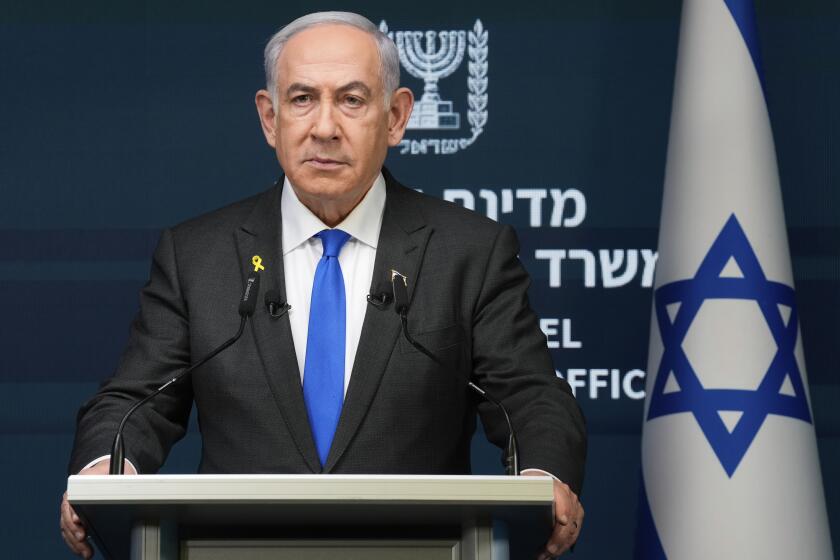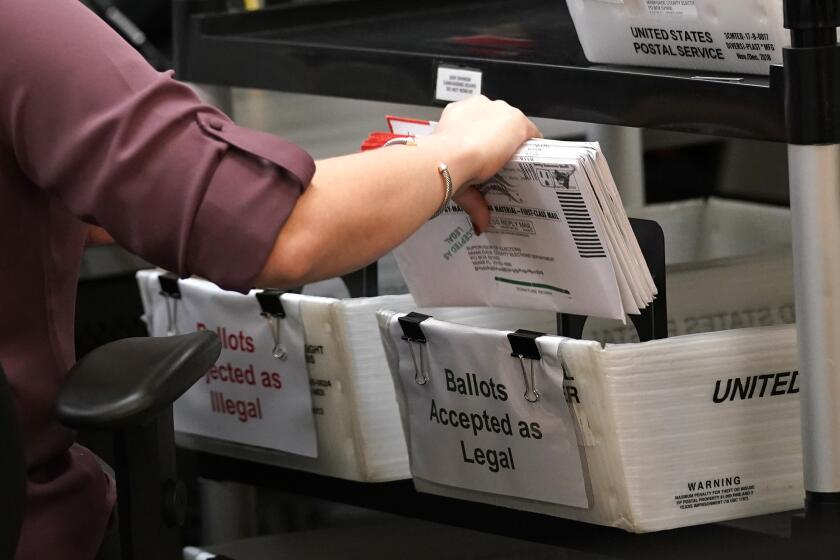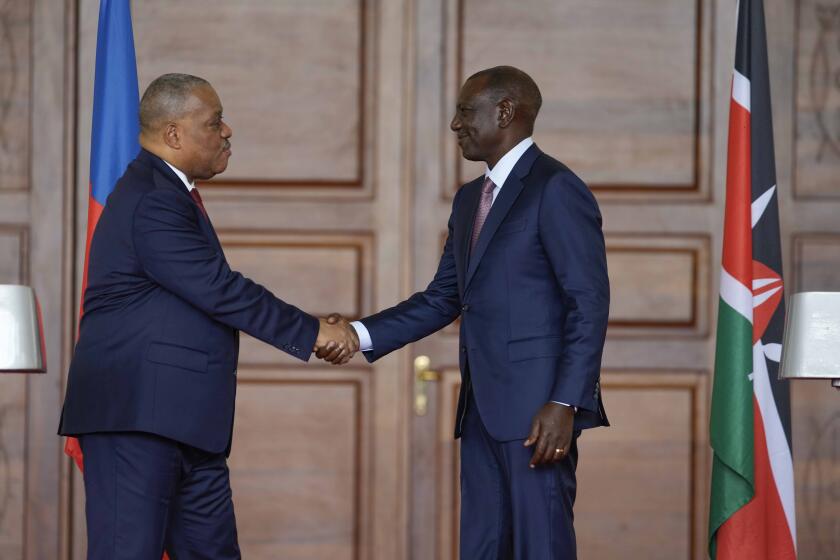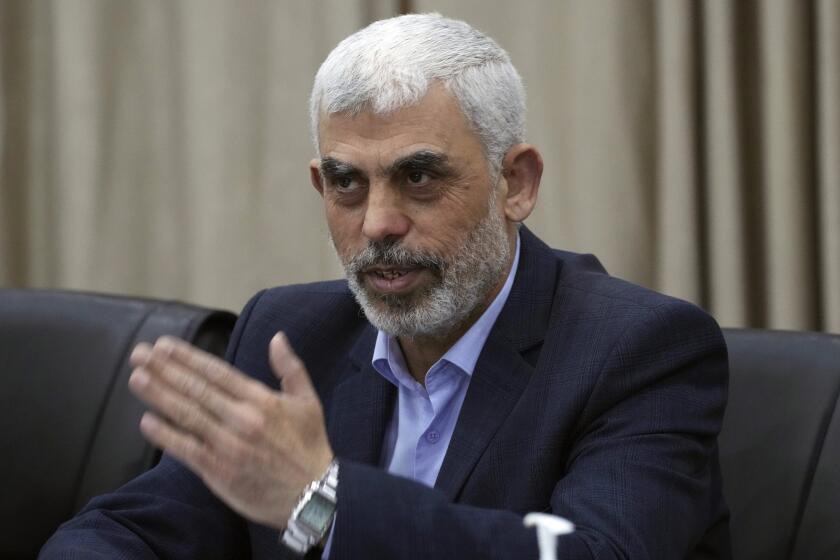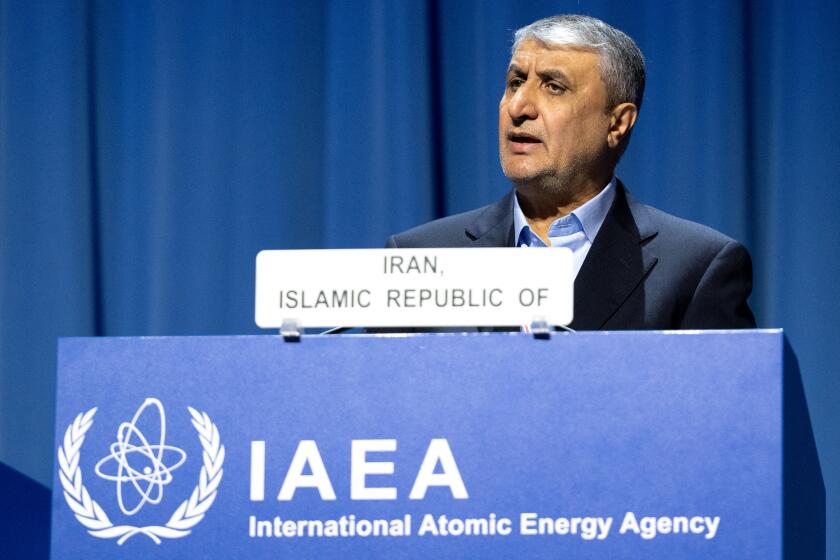U.S. Tanker Hits Mine Near Gulf : Explosion Occurs Outside Previous Sea Combat Zone
An American-operated supertanker carrying Iranian oil hit an underwater mine Monday in the Gulf of Oman--the region’s first reported mining outside the waters of the Persian Gulf.
As the almost seven-year-old war suffered that significant escalation, a convoy of American warships and three Kuwaiti-owned tankers inched its way towards Kuwait after the discovery of another mine in the shipping channels leading to the northern end of the Persian Gulf.
Iraq, meanwhile, announced that it had broken a de facto truce in the air war with Iran, sending fighter-bombers to attack oil installations in the north and southeast. Iran reported that a number of workers had been killed.
Noontime Explosion
Shipping officials said the 250,015-ton supertanker Texaco Caribbean, owned by Lexington Tankships Ltd., a subsidiary of Texaco Panama Inc., and operated by the National Bulk Carrier Corp. of New York, hit the mine at midday as it was entering the anchorage off Fujaira, a port on the eastern coast of the United Arab Emirates.
The blast blew a three-foot-long hole in the ship’s left side, just below the waterline. The ship had taken on a full load of crude oil from Iran’s Larak Island terminal, where Iranian tankers unload oil that they carry from Kharg Island in the northern gulf, about nine hours before. Shipping officials said that by nightfall, oil was still leaking into the sea, causing substantial pollution of the waters around Fujaira.
No Injuries to Crew
A statement from Texaco Inc. of White Plains, N.Y., said there were no injuries to the tanker’s crew. The ship is on lease for one trip to a Norwegian trading company, Seateam, and the cargo of crude oil, belonging to Seateam, was destined for Western Europe, the statement said. Shipping sources in the gulf said the destination was Rotterdam, in the Netherlands.
Despite the U.S.-Iranian conflicts, there are no restrictions on U.S. handling or importing of Iranian oil, according to the U.S. Department of Energy. About 45,000 barrels a day of Iranian crude currently reach U.S. Gulf Coast ports, the American Petroleum Institute said. That is roughly 1% of total crude imports, but this is up sharply from a year ago.
Shipping officials said that it seemed certain that the mine hit by the Texaco Caribbean had been laid recently, perhaps in an effort by Iran to damage one of the four American warships that set off Saturday in a convoy for Kuwait from anchorages not far from Fujaira.
Iranian naval forces held maneuvers in the Persian Gulf and Gulf of Oman for four days last week. Those exercises included practice in the laying of mines.
Shipping sources said that if Iran is sowing mines in the area, it would hurt its own operations. Almost all of Iran’s oil exports are shipped from a floating transit terminal at Larak Island.
In Washington, Pentagon spokesman Robert B. Sims said the incident should “demonstrate to all who lay mines in the Persian Gulf or its environs that this is an indiscriminate weapon” that can endanger the shipping of all nations operating in those waters.
The mine explosion represented a significant escalation of the Iran-Iraq War, which had been previously confined to the waters of the Persian Gulf. The mining of the waters off Fujaira is expected to cause an uproar in the shipping world, which had used this port--and the port of Khawr Fakkan to the north--as havens from the war.
There are between 50 and 75 oil tankers lying at anchor off the eastern coast of the Emirates because the waters had been considered safe there. The ships are unloading or transferring cargoes, or waiting for what appears to be a safe time to begin a journey up the Persian Gulf.
Ships traveling in the Strait of Hormuz or the Persian Gulf must pay substantial war-risk insurance premiums. One immediate result of the Texaco Caribbean mine explosion could be the extension of war-risk insurance to the Gulf of Oman, forcing ship owners to move their vessels out of the region.
In addition to merchant ships in the area, the United States has nine vessels, with 3,800 military personnel on board, formally assigned to the Middle East Task Force escorting tankers in the gulf, according to Sims.
In addition, the U.S. amphibious assault ship Guadalcanal is expected shortly in the Gulf of Oman carrying Sea Stallion helicopters for mine-hunting in the northern Persian Gulf.
The convoy of American warships and Kuwaiti tankers, which were re-registered in the United States as part of President Reagan’s gulf protection plan, was reported late Monday to be slowly making its way toward Kuwait after interrupting its journey because of the discovery of another mine, also apparently laid recently.
Asked to comment, Sims said only that “mines have hit ships there--mines have been seen there. We are concerned about those mines, and as we move ahead, we’ll try to counter them. We’ll go at whatever speed of advance is best in order to get safe passage through there.”
U.S. mine-detecting helicopters sent to the gulf previously were said Monday to be deployed in front of the convoy in the search for mines. The convoy itself, which entered the gulf led by a guided missile cruiser, now has a Kuwaiti tanker, the Sea Isle City, in the vanguard. The tankers draw more water than the American warships and are better constructed to withstand the blast of a mine.
Shipping experts say the Texaco Caribbean did not blow up or catch fire when it hit the mine because crude oil cargoes almost never ignite and explode on supertankers. In most such cases, not enough air enters the cargo compartment to ignite the vapors. Damage is further contained by the fact that there are up to 33 separate steel cargo compartments on a tanker, and those along the hull of the vessel where puncture is most likely are the smallest ones, containing the least oil.
The convoy operation is the second under the U.S. Administration’s program of re-registering a total of 11 Kuwaiti vessels, thereby entitling them to U.S. protection.
During the first convoy, a 401,000-ton supertanker, the Bridgeton, hit a mine about 18 miles west of Iran’s Farsi Island, about 120 miles from Kuwait, on July 24. Despite taking a hole on one side, the Bridgeton has been loaded with about two-thirds of its crude oil capacity and is expected to leave Kuwait before the end of the month for Fujaira, where it will unload the crude before entering dry dock in Dubai to be repaired.
In the air war, Iraq announced Monday that its warplanes attacked the Iranian oil refinery in Tabriz in northeast Iran and the oil fields of Bibi Hakimeh, Marun, Karanj and Kaj Sran, which are clustered in the southeast of the country near Ahvaz.
Baghdad radio said Iran had gone too far in its attacks on Iraq’s border and residential districts and “deserved back-breaking and painful blows by Iraq.”
Iran acknowledged the raid on Tabriz and Kaj Sran, saying “several workers were martyred and wounded” and damage was inflicted in both areas. It also said that an Iraqi Mirage F-1 fighter-bomber was shot down during the day while attempting to bomb southern Khuzistan province. The official Iranian news agency said the plane crashed near Bubiyan Island in the northern Gulf.
The U.N. Security Council adopted a unanimous resolution July 20 demanding that both sides observe a cease-fire in the conflict, which began in September, 1980, with Iraq’s invasion of Iran. Iraq accepted the resolution, but Iranian officials, while making negative comments, have not officially sent a reply.
The resolution raised the possibility of sanctions against either country if it violates the truce.
Times Staff writers Robert Gillette in Washington and Donald Woutat in Los Angeles contributed to this article.
More to Read
Sign up for Essential California
The most important California stories and recommendations in your inbox every morning.
You may occasionally receive promotional content from the Los Angeles Times.

